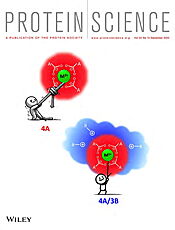Journal:Protein Science:4
From Proteopedia
(Difference between revisions)

| (44 intermediate revisions not shown.) | |||
| Line 1: | Line 1: | ||
| - | <StructureSection load='' size=' | + | <sup></sup><StructureSection load='' size='450' side='right' scene='10/1063617/009_fig_5b_new_450_450/1' caption='Acetylcholinesterase highlighting the 4A/3B motif'> |
===Why is binding of a divalent metal cation to a structural motif containing four carboxylate residues not accompanied by a conformational change?=== | ===Why is binding of a divalent metal cation to a structural motif containing four carboxylate residues not accompanied by a conformational change?=== | ||
| - | + | <big>Lushchekina, Weiner, Ashani, Emrizal, Firdaus-Raih, Silman & Sussman</big><ref>PMID: 39548604</ref> | |
<hr/> | <hr/> | ||
| - | + | [[Image:2024_Lushchekina_Prot_Sci_x.jpg| thumb |left|175px|Comparison of a divalent cation being <i>pulled</i> out of a 4A vs a 4A/3B motif [https://doi.org/10.1002/pro.5206 Go to paper]]] <b>Molecular Tour</b><br>''Torpedo californica'' acetylcholinesterase (''Tc''AChE) contains a unique 4D motif composed of four aspartate residues that can bind divalent metal cations (like Ca²⁺, Mg²⁺, Mn²⁺), significantly increasing the enzyme’s thermal stability. Despite the electrostatic repulsion expected between these ]aspartates, structural analysis shows that the enzyme's conformation remains stable <scene name='10/1063617/009_fig_metal_tcache_lab_png/2'>with</scene> or <scene name='10/1063617/009_fig_apo_tcache_lab_png/2'>without</scene> bound cations as seen in an <scene name='10/1063617/009_fig_metal_apo_tcache_lab/2'>overlay</scene> the two states and an | |
| - | [[Image:2024_Lushchekina_Prot_Sci_x.jpg| thumb |left| | + | <jmol> |
| - | + | ||
| - | + | ||
| - | + | ||
| - | ''Torpedo californica'' acetylcholinesterase (''Tc''AChE) contains a unique 4D motif composed of four aspartate residues that can bind divalent metal cations (like Ca²⁺, Mg²⁺, Mn²⁺), significantly increasing the enzyme’s thermal stability. Despite the electrostatic repulsion expected between these aspartates, structural analysis shows that the enzyme's conformation remains stable | + | |
| - | <scene name='10/1063617/009_fig_metal_tcache_lab_png/2'>with</scene> or <scene name='10/1063617/009_fig_apo_tcache_lab_png/2'>without</scene> bound cations as seen in an <scene name='10/1063617/009_fig_metal_apo_tcache_lab/2'>overlay</scene> the two states and an <jmol> | + | |
<jmolButton> | <jmolButton> | ||
<text>animation</text> | <text>animation</text> | ||
| Line 20: | Line 15: | ||
</script> | </script> | ||
</jmolButton> | </jmolButton> | ||
| - | </jmol> between them. The stability of the 4D motif is attributed to adjacent positively charged residues (Lys325, Arg388, and Arg517), forming stabilizing salt bridges, leading to the newly named <scene name='10/1063617/ | + | </jmol> between them. The stability of the 4D motif is attributed to adjacent positively charged residues (Lys325, Arg388, and Arg517), forming stabilizing salt bridges, leading to the newly named <scene name='10/1063617/009_fig_5b_new_450_450/1'>4A/3B motif</scene> (four acidic residues stabilized by three basic residues). |
| - | The study also identified additional metal-binding sites (His264 and His471 sites) in ''Tc''AChE through crystallographic analysis, but these appear to be weaker or crystallographic artifacts. Using metadynamics and molecular dynamics (MD) simulations with quantum potentials (QM/MM-MD), the binding strength of metal cations at the 4D site was compared to that of the 4D site in human fibrin-stabilizing factor (fXIIIa), which lacks stabilizing cationic residues. Results showed that while ''Tc''AChE’s 4A/3B motif maintains structural integrity upon metal binding/unbinding, the <scene name='10/1063617/ | + | The study also identified additional metal-binding sites (His264 and His471 sites) in ''Tc''AChE through crystallographic analysis, but these appear to be weaker or crystallographic artifacts. Using metadynamics and molecular dynamics (MD) simulations with quantum potentials (QM/MM-MD), the binding strength of metal cations at the 4D site was compared to that of the 4D site in human fibrin-stabilizing factor (fXIIIa), which lacks stabilizing cationic residues. Results showed that while ''Tc''AChE’s 4A/3B motif maintains structural integrity upon metal binding/unbinding, the <scene name='10/1063617/009_fig_8a_new_jmol_def/1'>fXIIIa motif </scene> is stable in presence of a metal ion but <scene name='10/1063617/009_fig_8b_new_def_jmol/1'>explodes</scene> without a metal ions due to electrostatic repulsion. This is seen clearly in an <jmol> |
<jmolButton> | <jmolButton> | ||
<text>animation</text> | <text>animation</text> | ||
| Line 28: | Line 23: | ||
var a = [1,2,3,4,5]; | var a = [1,2,3,4,5]; | ||
for(var i IN a) { | for(var i IN a) { | ||
| - | script /wiki/scripts/10/1063617/ | + | script /wiki/scripts/10/1063617/009_fig_8a_new_jmol_def/1.spt; delay 0.5 |
| - | script /wiki/scripts/10/1063617/ | + | script /wiki/scripts/10/1063617/009_fig_8b_new_def_jmol/1.spt; delay 0.5; |
} | } | ||
</script> | </script> | ||
| Line 35: | Line 30: | ||
</jmol> between these two states. | </jmol> between these two states. | ||
| - | The 4A/3B motif’s metal-binding strength is | + | The 4A/3B motif’s metal-binding strength is ~10 kcal/mol weaker than motifs with multiple anionic residues '''not''' surrounded by cationic residues. This flexibility. without conformational change. suggests the motif may act as a metal ion reservoir, potentially regulating metal concentrations. Similar motifs were found in other proteins, indicating a broader functional role beyond ''Tc''AChE. |
| - | <b>References</b | + | <b>References</b> |
<references/> | <references/> | ||
</StructureSection> | </StructureSection> | ||
__NOEDITSECTION__ | __NOEDITSECTION__ | ||
Current revision
| |||||||||||
This page complements a publication in scientific journals and is one of the Proteopedia's Interactive 3D Complement pages. For aditional details please see I3DC.

